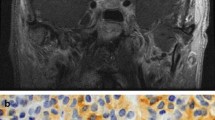Abstract
The reported cases of hyperthyroidism due to a TSH-secreting pituitary adenoma have steadily increased in previous years; however, information about the results and long term outcome after pituitary surgery is scanty.
Twenty-four patients with a TSH-secreting adenoma underwent pituitary surgery at our department in the last 15 years. Hypersecretion of other pituitary hormones was diagnosed in 7 patients. Three patients were euthyroid at the time of surgery because of previous ablative thyroid therapies.
The success rate of surgery strictly depends on the criteria used. Normalization of elevated FT3 and FT4 levels occurred in 17 of the 21 patients with preoperative hyperthyroidism: however, only those with early postoperative undetectable TSH level (12 cases) had no recurrence of disease during follow-up and no residual tumor tissue on postoperative MRI, whereas recurrence of hyperthyroidism occurred in 3 of the 5 patients without postoperative TSH inhibition. All 3 euthyroid patients had a subtotal removal of the tumor, as judged by postoperative MRI.
Surgical removal is the therapy of choice of TSH-secreting adenomas, whereas radiotherapy and medical treatment with somatostatin analogues are usually reserved to patients with incomplete tumor removal. A thorough postoperative evaluation is necessary to discriminate between complete and partial remission of disease.
Similar content being viewed by others
References
Beck-Peccoz P, Persani L. Thyrotropin (TSH)-secreting pituitary tumors: endocrinology, clinical aspects and treat-ment. In: Landolt AM, Vance ML, Reilly PL, eds. Pituitary Adenomas: Biology, Diagnosis and Treatment. London: Churchill Livingstone, 1996;139–155.
Ambrosi B, Faglia G, and the Multicenter Pituitary Tumor Study Group, Lombardia Region. Epidemiology of pituitary tumors. In: Faglia G, Beck-Peccoz P, Ambrosi A, Travaglini P, Spada A, eds. Pituitary Adenomas: New Trends in Basic and Clinical Research. Amsterdam: Excerpta Medica, 1991;159–168.
Mindermann T, Wilson CB. Thyrotropin-producing pituitary adenomas. J Neurosurg 1993;79:521–527.
Smallridge RC. Thyrotropin-secreting pituitary tumors. Endocrinol Metab Clin 1987;16:765–792.
Refetoff S, Weiss RE, Usala SJ. The syndromes of resistance to thyroid hormone. Endocr Rev 1993;14:348–399.
Beck-Peccoz P, Chatterjee VKK. The variable clinical phenotype in thyroid hormone resistance syndrome. Thyroid 1994;4:225–232.
Beck-Peccoz P, Roncoroni R, Mariotti S, et al. Sex hormonebinding globulin measurement in patients with inappropriate secretion of thyrotropin (IST): Evidence against selective pituitary thyroid hormone resistance in nonneoplastic IST. J Clin Endocrinol Metab 1990;71:19–25.
Watanabe K, Kameya T, Yamauchi A, et al. Thyrotropin producing adenoma associated with pituitary resistance to thyroid hormone. J Clin Endocrinol Metab 1993;76: 1025–1030.
Hill SA, Falko JM, Wilson CB, Hunt WE. Thyrotrophin-producing pituitary adenomas. J Neurosurg 1982;57:515–519.
Grisoli F, Leclercq T, Winteler JP, et al. Thyroid-stimulating pituitary adenomas and hyperthyroidism. Surg Neurol 1986;25:361–368.
McCutcheon IE, Weintraub BD, Old~eld EH. Surgical treatment of thyrotropin-secreting pituitary adenomas. J Neurosurg 1990;73:674–683.
Beckers A, Abs R, Mahler C, Vandalem JL, Pirens G, Hennen G, Stevenaert A. Thyrotropin-secreting pituitary adenomas: Report of seven cases. J Clin Endocrinol Metab 1991;72:477–483.
Losa M, Giovanelli M, Persani L, Mortini P, Faglia G, Beck-Peccoz P. Criteria of cure and follow-up of central hyperthyroidism due to thyrotropin-secreting pituitary adenomas. J Clin Endocrinol Metab 1996;81:3084–3090.
Bertherat J, Brue T, Enjalbert A, et al. Somatostatin receptors on thyrotropin-secreting pituitary adenomas: Comparison with the inhibitory effects of octreotide upon in vivo and in vitro hormonal secretions. J Clin Endocrinol Metab 1992;75:540–546.
Losa M, Magnani P, Mortini P, et al. Indium-lll pentetreotide single-photon emission tomography in patients with TSHsecreting pituitary adenomas: Correlation with the effect of a single administration of octreotide on serum TSH levels. Eur J Nucl Med 1997;24:728–731.
Gancel A, Vuillermet P, Legrand A, Catus F, Thomas F, Kuhn JM. Effects of a slow-release formulation of the new somatostatin analogue lanreotide in TSH-secreting pituitary adenomas. Clin Endocrinol (Oxf) 1994;40:421–428. Surgical Therapy of TSHomas 131
Author information
Authors and Affiliations
Rights and permissions
About this article
Cite this article
Losa, M., Mortini, P., Franzin, A. et al. Surgical Management of Thyrotropin-Secreting Pituitary Adenomas. Pituitary 2, 127–131 (1999). https://doi.org/10.1023/A:1009987530852
Issue Date:
DOI: https://doi.org/10.1023/A:1009987530852




